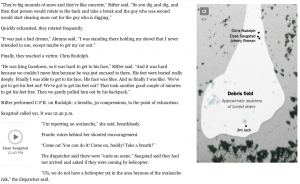By CHARLOTTE MACKINNON
The young adults of today’s generation are the ones who have grown up with the Internet and have learned how to harness its unique powers – most notably in the forms of social media sites such as Facebook, Twitter, and Instagram.
Inevitably, the prominence of social media in every day life has impacted the way news is communicated and shared. While it seems to be a common trend for teenagers and other young people to ignore major online news hubs such as the Wall Street Journal, The New York Times or The Washington Post among others, this young generation of Internet users are still getting exposure to the major stories of the moment.
The accessibility of such content stems from the new-age journalistic style that has established a major presence on social media – and no news company has made a bigger name for itself with the younger generation than BuzzFeed.
BuzzFeed was founded in 2006 by Jonah Peretti and Kenneth Lerer, and the site’s content has since reached a global audience of more than 200 million. According to the website, it is “re-defining online advertising with its social, content-driven publishing technology” – and judging by its popularity and ubiquity across the world wide web, it is generally considered to be the face of future journalism.
When BuzzFeed first came onto my radar a year or two back, the site was best known for its “listicles” (list + articles), quizzes, clever GIFs (brief animated clips), and coverage of light-hearted material like celebrities and pop culture. I first discovered BuzzFeed through Facebook – I would constantly see my friends sharing links to funny or relatable articles with their friends, and due to the very public nature of Facebook’s stream, the same links would often be shared over and over again.
Users would acknowledge the articles on their news feed, and if feeling the same connection to it, be prompted to re-post it elsewhere. That’s how Buzzfeed has attracted so many viewers – it thrives off of traffic generated by third-party sites like Facebook and other social media outlets (Twitter), opening the floodgates to global exposure and allowing for its content to “go viral”.
What makes Buzzfeed such a successful new form of journalism is that the structure of the stories really work with social media. The pieces are often quirky, visually creative, and often take an angle that is relatable to younger generations. This obviously poses a major contrast to traditional style of news stories that you can find on the more serious news publications of today, like the ones I listed above. The types of stories that trend on Facebook aren’t wordy and academic; they’re short, fun pieces with headlines and pictures that immediately grab a user’s attention as they scroll down their newsfeed.
You might object, saying that a lot of the Buzzfeed content that goes viral isn’t really news – and yes, it’s true that a lot of it really is just silly speculation on trivial issues that are published for entertainment above anything. That may be how the site first took off, but it certainly isn’t how it’s operating today. Buzzfeed now covers all kinds of global news, whether it be on the economy, tech or politics. Scrolling down the site, one can find anything from “16 Magical Gifts All Unicorn Lovers Will Appreciate” to dispatches about the war in eastern Ukraine or terrorist attacks in Kenya.
Journalism is constantly evolving as new technologies reshape the way we communicate. I don’t know how the technological developments of the future will change the landscape of how news is shared in the coming decades, but the form of journalism that characterizes Buzzfeed is certainly redefining the kind of news we relied on in the past. In the world of print journalism, it is important to note how social media have become a platform for not just social contact between peers, but for the distribution of news as well. It will be interesting to see how this new style of journalism flourishes in the coming years and the ways in which it impacts the younger generations.



 On top of that, many attendees find themselves in need of medical care every year during the festival, resulting in hundreds of fire rescue calls.
On top of that, many attendees find themselves in need of medical care every year during the festival, resulting in hundreds of fire rescue calls.![image[2]](http://students.com.miami.edu/reporting/wp-content/uploads/2014/10/image2-300x187.jpg)
